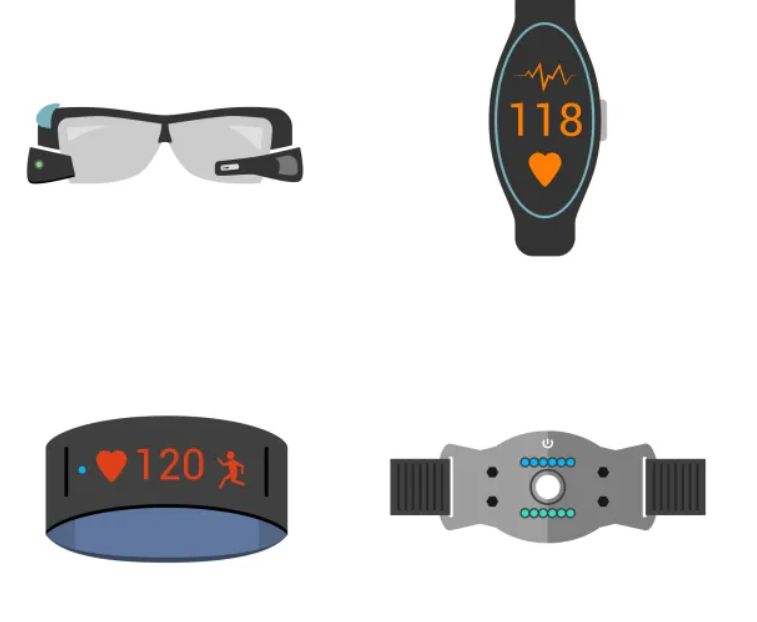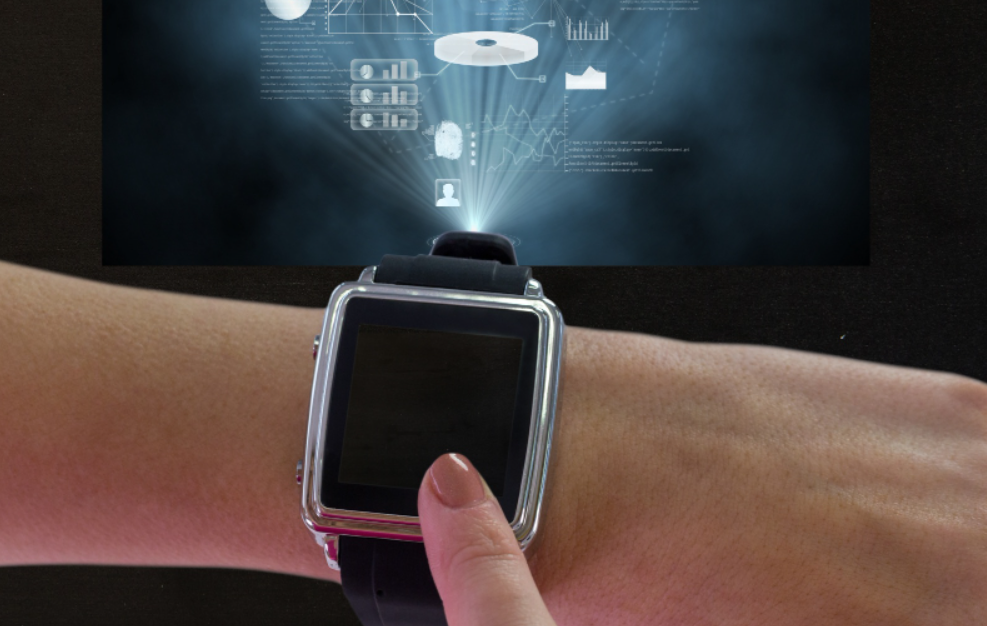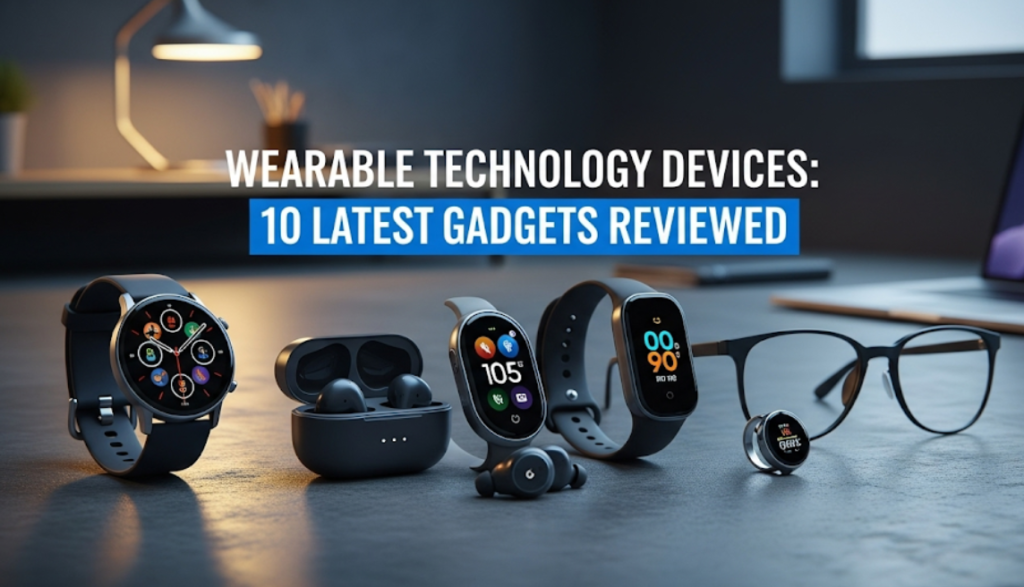The Smart Revolution on Your Wrist
The use of wearable technology devices has totally transformed our way of life, our work, and our health. No longer are these smart gadgets mere fancy accessories. They are potent devices that monitor our wellbeing, keep us in touch and simplify life.
Modern-day wearables are capable of far more than step counting. They check heart rates, sleep habits and even identify health issues before they escalate to serious levels. Fitness enthusiasts and busy professionals will all be able to find a wearable device that suits their lifestyle.
The smartphone gadgets market is fast expanding. By 2025, researchers have estimated that more than 500 million persons will have used some form of wearable technology. This article discusses the 10 best wearable devices you should purchase today.
Best Smart Wearables That Dominate in 2025
Apple Watch Series 9 – The Best Choice
Apple Watch Series 9 tops the list of wearable technology devices. The features of this smartwatch are amazing and makes it worth every penny.
Key Features:
- Smartwatch and blood oxygen device
- Retina display over 45 percent larger than earlier models
- Up to 18 hours of battery life
- Water resistant up to 50 meters
- Complete integration with iPhones and other Apple devices
Pros:
- High quality of building and material
- In-depth health monitoring features
- Thousands of apps in one big app ecosystem
- Fast charging technology
Cons:
- Only works with iPhones
- Very costly relative to other alternatives
- Battery life could be better
Price Range: $399 – $799
Apple Watch Series 9 does a great job in monitoring health and fitness. It is able to pick up irregular heart beats and even call help in case of a serious fall. Its interface is user-friendly and well-polished and can suit both beginners and experts in technology.
Samsung Galaxy Watch6 – The Best Friend of Android
The Galaxy Watch6 is one of the most amazing Android wearable technology products manufactured by Samsung. It is fashionable and has great functionality.
Key Features:
- Easy navigation through rotating bezel
- Smart sleep monitoring with in-depth analysis
- Built-in GPS to record workouts correctly
- 40+ exercise classes such as swimming
- Bixby voice assistant
Pros:
- Compliments Android phones perfectly
- Superior battery life (as high as 40 hours)
- Long-lasting construction and military grade protection
- Extensive fitness capabilities
Cons:
- Poor use with iPhones
- Starting to use interface can be hectic
- Some apps are slow to load
Price Range: $329 – $429
What’s interesting about this smartwatch is the rotating bezel control. It renders browsing through menus as something intuitive and natural. The health tracking is of the highest quality, particularly the sleep analysis and stress monitoring.
Fitbit Charge 5 – The Fitness King
| Feature Specification | Details |
|---|---|
| Battery Life | Up to 7 days |
| Water Resistance | 50 meters |
| GPS | Built-in |
| Heart Rate Monitor | 24/7 tracking |
| Stress Management | Yes |
| Sleep Tracking | Advanced |
Fitbit Charge 5 is health and fitness focused. It is among the best wearable technology products that individuals seeking professional fitness tracking without smartphone capabilities can have.
Key Features:
- Built-in GPS to accurately track distance
- Guided breathing stress management tools
- 20+ exercise modes
- Fitbit Premium membership included
- ECG and skin temperature monitors
Pros:
- Good battery life of up to a week
- Precise fitness and health monitoring
- Slim and comfortable design
- Great value for money
Cons:
- No music storage or playback
- Not maximum smart features like full smartwatches
- The small screen is not easy to read
Price Range: $179 – $199
The Charge 5 does a great job of encouraging the user to be active. It makes exercising more enjoyable because of its fitness features and social characteristics. The sleep monitoring is truly detailed, presenting the various sleep states and recovery numbers.
Smart Rings and Smaller Wearables
Oura Ring Generation 3 – Invisible Health Tracking
The Oura Ring is another new type of wearable technology device. This smart ring monitors your health 24/7 without anyone realizing that you have a tech device on.
Key Features:
- Continuous cardiac and thermal monitoring
- Premium sleep tracking and recovery details
- Calorie and steps tracking
- Long battery life (up to 7 days)
- Swimming/shower proof
Pros:
- Very discrete and fashionable
- Incredible power capacity
- Very precise health measurements
- You can wear it all day long
Cons:
- High cost monthly subscription required
- Limited functionality compared to smartwatches
- No screen or notifications
- The sizing should be ideal in terms of accuracy
Price Range: $299 – $399
The Oura Ring is designed to suit individuals who do not wish to be seen wearing a health device. It is particularly popular among athletes and health-conscious workers who do not need big tech.

Whoop 4.0 – The Athlete’s Choice
The Whoop 4.0 targets people who are serious about their fitness and exercises. This wearable technology tool is completely performance and recovery-oriented.
Key Features:
- Continuous physiological testing
- Coaching based on your body’s readiness
- Recommendations on sleep optimization
- Heart rate variability monitors
- Regular hardware updates included in monthly subscription fee
Pros:
- Incredibly extensive fitness and recovery information
- No screen equals longer battery life
- Waterproofing that suits swimmers
- New software features added regularly
Cons:
- Needs subscription fee
- No display or smart features
- Time to learn all the data
- Would not suit casual fitness users
Pricing Model: $30/month subscription
Whoop takes a different approach as it targets three main metrics: strain, recovery, and sleep. It can give athletes insight into when to work more intensely and when to take a break to perform best.
Augmented Reality Wearables and Smart Glasses
Ray-Ban Meta Smart Glasses – Fashion Meets Technology
These intelligent glasses integrate retro Ray-Ban designs with technology. They are one of the trendiest wearable technology gadgets currently in the market.
Key Features:
- Built-in photo and video cameras
- Audio system with open ear, call and music
- Meta AI voice assistant
- Slim design that looks like any other glasses
- Several frame designs and lenses
Pros:
- Appear just like ordinary Ray-Ban sunglasses
- Good sound without stuffing ears
- Easy photo and video capture
- All-day battery life
Cons:
- Privacy concerns through built-in cameras
- Limited functionality compared to other wearables
- High cost for what they provide
- Need to charge the case regularly
Price Range: $299 – $379
These smart glasses suit content creators and individuals seeking hands-free photo and video recording. The sound quality is surprisingly impressive, making them very nice for phone calls and music.
Google Pixel Buds Pro – True Wireless Excellence
Google Pixel Buds Pro is an audio wearable technology device that extends beyond the basics. These earbuds have high-quality features at an affordable cost.
Key Features:
- Active noise cancelling transparency mode
- 11-hour battery life including charging case
- Seamless Android integration
- Live language translation
- Rich sound custom 11mm drivers
Pros:
- High-quality sound and noise cancelling
- Comfortable for long-term wear
- Easy compatibility with Android devices
- Essential translator tools for travel
Cons:
- Limited features on iPhones
- Case is bulkier than competitors
- Touch controls are prone to accidental activation
- Base model has no wireless charging
Price Range: $199 – $229
The best feature is the real-time translation. With the earbuds translating speech in real time, you can have conversations in another language. This makes them highly useful when traveling to different places.
Health and Medical Wearables Specialty
Dexcom G7 – Diabetes Innovation
The Dexcom G7 is a medical-grade wearable technology device that can assist people with diabetes to better manage their condition.
Key Features:
- Continuous glucose monitoring without finger pricks
- One-minute glucose readings
- High and low glucose alerts
- 10-day sensor wear time
- Smartphone and smartwatch integration
Pros:
- Life-changing for diabetes sufferers
- Very precise glucose levels
- Eliminates frequent finger pricks
- Shares information with family and physicians
Cons:
- Prescription required by physician
- Costly without insurance
- Sensor needs replacement every 10 days
- Only useful for diabetics
Price: $70-150/month (depends on insurance)
This device has transformed diabetes treatment. Users can view the impact of food, exercise and stress on their blood sugar in real-time. Most users experience improved glucose regulation and reduced diabetes complications.
Withings ScanWatch – Medical Grade Monitoring
The Withings ScanWatch is designed as a traditional watch and provides high-tech health monitoring. It is the most medically accurate among wearable technology devices.
Key Features:
- Heart rhythm analysis (ECG) monitoring
- Blood oxygen level measurement
- Sleep apnea detection
- Up to 30 days battery life
- FDA-approved medical features
Pros:
- Appears to be a conventional luxury watch
- Exceptionally long battery life
- Medical-grade accuracy in health measurements
- iOS and Android compatible
Cons:
- Lacks smart capabilities compared to other smartwatches
- Expensive for casual users
- Small digital display is difficult to read
- Complex to set up
Price Range: $279 – $329
This watch suits individuals who want serious health monitoring in a classic watch design. Its medical-grade characteristics have made this device popular among health-conscious consumers and healthcare professionals.

Fitness and Activity Monitors
Garmin Venu 3 – The Complete Package
Garmin Venu 3 is a device that features smartwatch capabilities and in-depth fitness tracking. It is among the most versatile wearable technology gadgets for active lifestyles.
Key Features:
- Built-in multi-satellite GPS
- 14 days battery life in smartwatch mode
- Over 30 built-in sports apps
- Music storage for 2,650+ songs
- Advanced training data and recovery analytics
Pros:
- Exceptional battery life
- Comprehensive sports fitness tracking
- Excellent GPS accuracy
- Durable construction made to withstand outdoor exposure
Cons:
- Interface is less modern compared to Apple or Samsung
- Limited selection of third-party apps
- Pricey compared to simple fitness trackers
- Learning curve for advanced features
Price Range: $449 – $499
Garmin excels with battery life and GPS accuracy. Athletes love the detailed training metrics and weeks of use without charging. Hikers, runners, and cyclists benefit from the outdoor features.
Amazfit GTR 4 – Affordable Luxury
The Amazfit GTR 4 proves that wearable technology devices don’t have to be costly to be effective. This smartwatch has high-end features at a fraction of the price.
Key Features:
- 14 days battery life with normal usage
- Built-in GPS and 150+ sports modes
- Always-on AMOLED display
- 24/7 health monitoring including stress and sleep
- Waterproof to 50 meters
Pros:
- Outstanding value for money
- Excellent battery life
- Extensive health and fitness monitoring
- Gorgeous display and design
Cons:
- Limited app ecosystem
- Notification handling issues
- Not all health measurements are as precise as premium brands
- Customer support can be slow
Price Range: $199 – $249
This watch offers 80 percent of premium smartwatch features at half the price. It’s ideal for individuals who need comprehensive tracking without emptying their wallets.
Comparison Table: The Best Wearable Technology Gadgets
| Device | Battery Life | Price Range | Best For | Water Resistance |
|---|---|---|---|---|
| Apple Watch Series 9 | 18 hours | $399-799 | iPhone users | 50m |
| Samsung Galaxy Watch6 | 40 hours | $329-429 | Android users | 50m |
| Fitbit Charge 5 | 7 days | $179-199 | Fitness tracking | 50m |
| Oura Ring Gen 3 | 7 days | $299-399 | Discreet health monitoring | Waterproof |
| Whoop 4.0 | 5 days | $30/month | Athletes | Waterproof |
| Ray-Ban Meta | 4 hours | $299-379 | Content creation | Not waterproof |
| Google Pixel Buds Pro | 11 hours | $199-229 | Audio/calls | IPX4 |
| Dexcom G7 | 10 days | $70-150/month | Diabetes monitoring | Waterproof |
| Withings ScanWatch | 30 days | $279-329 | Medical monitoring | 50m |
| Garmin Venu 3 | 14 days | $449-499 | Serious athletes | 50m |
| Amazfit GTR 4 | 14 days | $199-249 | Budget-conscious users | 50m |
The Future of Wearable Technology
Wearable technology gadgets are evolving rapidly. Future devices will likely contain:
- Smart AI that learns your habits and preferences
- Extended battery technologies lasting weeks instead of days
- Non-invasive blood glucose monitoring for everyone
- Advanced stress and mood monitoring
- Augmented reality contact lenses and glasses
There will also be enhanced integration between various wearables. Your smartwatch, earbuds, and smart ring will collaborate to give a complete picture of your health and activities. As AI technology continues to advance, we can expect even more sophisticated health monitoring and predictive analytics in future wearable devices.
For more detailed information about wearable technology standards and regulations, you can visit the FDA’s guidance on digital health tools.
Which Wearable Should You Choose?
The right wearable technology device depends on your needs and lifestyle:
For iPhone users: Apple Watch Series 9 provides excellent integration and capabilities
For Android users: Samsung Galaxy Watch6 is a great-performing and fashionable watch
For fitness tracking: Fitbit Charge 5 or Garmin Venu 3 are excellent for tracking activities
For discreet monitoring: Oura Ring Generation 3 offers invisible health monitoring
For athletes: Whoop 4.0 is dedicated to performance optimization and recovery
For budget-conscious users: Amazfit GTR 4 has quality features at a lower cost
For medical needs: Withings ScanWatch or Dexcom G7 provide medical-quality monitoring
Tips to Maximize Your Wearable
- Wear it daily – Wearables work best with 24/7 usage
- Set achievable goals – Start with easy targets and gradually increase them
- Use the companion app – Most insights come from the smartphone app, not just the device
- Keep it charged – Develop a charging routine that fits your schedule
- Update regularly – Install software updates to access new features and improvements
Frequently Asked Questions
Q: Are wearable technology devices accurate for health monitoring? A: Generally, today’s wearables are fairly accurate for basic measurements like heart rate and steps. However, they are not medical devices and should not replace professional medical advice. For serious health concerns, consult a doctor.
Q: Can I use my wearable device while swimming? A: Most modern wearable devices are waterproof and suitable for swimming. Check the specific water resistance rating – devices with 50m or 5ATM ratings can be used in pools and showers.
Q: How often should I charge my wearable device? A: This varies by device. Smartwatches typically require daily charging, while fitness trackers can last 5-7 days. Smart rings and specialized devices can have even longer battery life.
Q: Are wearable technology devices compatible with all smartphones? A: Most wearables work with both iPhone and Android, though some features may be limited. Apple Watch only works with iPhone, and some Android-focused devices have reduced compatibility with iPhone.
Q: Can wearable devices be worn all the time? A: Yes, current wearables are designed for 24/7 wear. They use low-power sensors and produce minimal electromagnetic radiation that’s well below safety levels.
Q: Are there wearable technology devices suitable for children? A: Yes, many wearables have kid-friendly versions with parental controls and safety features. However, consider privacy concerns and age-appropriate functionality.
Q: How long do wearable devices typically last? A: Most quality wearables last 2-4 years with regular use. Battery degradation and software updates eventually necessitate replacement, though many users upgrade for new features before their device fails.
Q: Do I need a smartphone to use a wearable device? A: Most devices require a smartphone for initial setup and full functionality. Some offer cellular connectivity for standalone operation, but these are typically more expensive.
Conclusion: Your Next Smart Step
Wearable technology is no longer just about step counting – it’s become sophisticated health monitoring technology. The 10 devices discussed in this article represent the best options in 2025, each excelling in different areas.
The key is finding a device that matches your lifestyle and goals. Whether you’re a fitness enthusiast, health-conscious individual, or tech lover, there’s an ideal wearable for you.
Remember, the most valuable wearable device is the one you’ll actually wear consistently. Consider factors like battery life, comfort, and the features most important to you. The right choice will make your new wearable a valuable part of your daily routine.
The future of wearable technology looks bright, with groundbreaking innovations emerging regularly. By investing in one of these top-rated devices, you’re not just buying a gadget – you’re investing in your health, productivity, and connection to the digital world.

